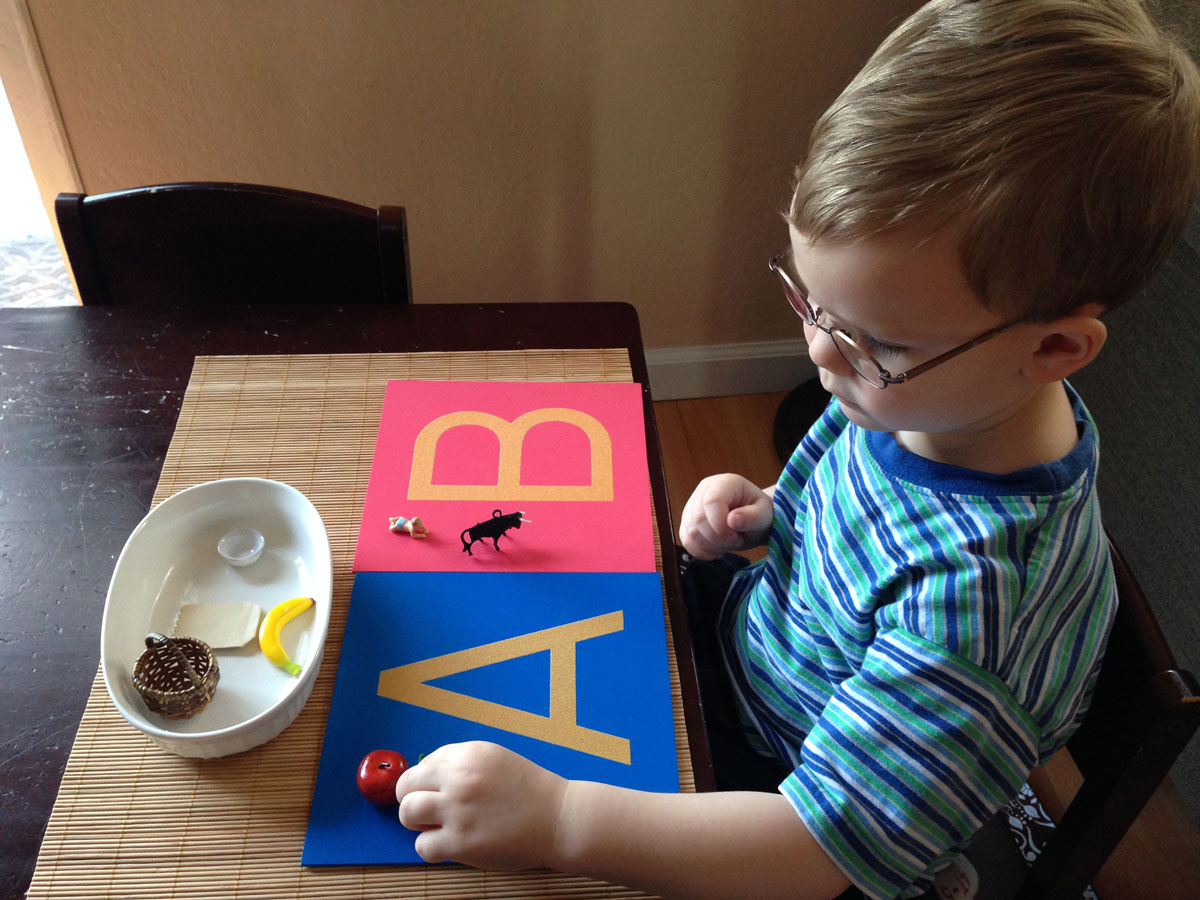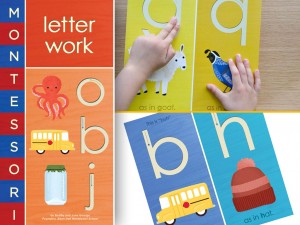Montessori Sandpaper Letters
Maria Montessori famously said, “What the hand does, the mind remembers.”
This principle guided the creation of Dr. Montessori’s now-famous and renowned method, which engages children with hands-on learning. One of these hands-on learning materials, Montessori sandpaper letters, is an indispensable early literacy work in Montessori homes and classrooms.
In this article, we’ll answer some of the most common questions surrounding sandpaper letters, including, “When is a child ready for sandpaper letters?“, “Are there any alternatives to expensive sandpaper letter sets?” and more.

What Are Sandpaper Letters?
Montessori sandpaper letters are wooden rectangles embossed with a sandpaper letter for each letter of the alphabet. Traditionally, the letters themselves are made from yellow sandpaper and mounted on a blue rectangle for vowels and a pink rectangle for consonants. In a classroom or homeschool environment, Montessori educators use these letters to introduce children to written letters.
Sandpaper letters come in both lowercase and uppercase sets. A child should learn lowercase letters first, since the majority of letters in written language are in their lowercase form.
What Are The Benefits of Montessori Sandpaper Letters?
Sandpaper letters beautifully engage the visual, auditory, and tactile senses. As a child learns a sandpaper letter, they see the contrast of the letter on bright-colored wood. They hear their guide or parent saying the letter sound that corresponds with the letter. And, of course, they feel the shape of the letter as they trace their fingers on the sandpaper.
This tactile, sensory approach helps children internalize letters. Tracing the letters also prepares them for writing.
When Is a Child Ready for Sandpaper Letters?
It’s best to introduce sandpaper letters after a child is familiar with the letter sounds. In Montessori, children learn the concrete before progressing to the abstract. For example, they first learn the concrete sounds they use every day to create words before learning the abstract letters we use to represent those words.
Once a child recognizes that words are broken down into sounds and can also recognize and isolate those sounds — usually with the help of Montessori sound games — they’re ready to work with sandpaper letters.
Like in all things Montessori, we can’t give a hard-and-fast age for when a child will be ready for this material. The best approach is to follow the child and their own readiness signs and interest. For many children, but certainly not all, this happens between the ages of 3 and 4.
How Do I Introduce Sandpaper Letters?
Parents and teachers introduce sandpaper letters using a Montessori 3 period lesson. In the 3 period lesson, the parent first introduces, then identifies, and finally tests the child on the new information.
First is the introduction of the new information. In this example, a parent may say, “This is ‘buh,'” while tracing the shape of the letter with two fingers. After introducing the letter, the parent will then ask the child to identify it and trace it. “Show me ‘buh.'” Finally, the parent signals to the letter and tests the child’s understanding by asking, “What is this?”
Start with just a few letters at a time. The goal isn’t to drill the child or make them feel overwhelmed, but to set them up for success.
This video on introducing the sandpaper letters with a 3 period lesson is a helpful resource to visualize how this process unfolds.
Once the child has begun working with the Montessori sandpaper letters, you can continue presenting them in a variety of ways. You may include sandpaper letters in a Montessori language basket with objects that start with that letter. You can present a few different sandpaper letters that your child can match with corresponding language miniatures.
In What Order Do I Introduce Sandpaper Letters?
 To understand why Montessori takes a nontraditional approach to the order of introducing sandpaper letters, it may be helpful to imagine an aspiring musician learning to play guitar. It wouldn’t make sense to first learn the A chord, then B, then C, and so on in sequential alphabetical order. A better approach would be to learn common, versatile chords that allow them to begin playing songs.
To understand why Montessori takes a nontraditional approach to the order of introducing sandpaper letters, it may be helpful to imagine an aspiring musician learning to play guitar. It wouldn’t make sense to first learn the A chord, then B, then C, and so on in sequential alphabetical order. A better approach would be to learn common, versatile chords that allow them to begin playing songs.
Such is also the case with learning letters. Montessori children don’t learn letters in traditional alphabetical order, but in an order that helps them form words quickly, even before they know the entire alphabet.
Montessorians differ on what the “best” specific order is to achieve that goal. We like the order that Tim Seldin outlines in “How to Raise an Amazing Child the Montessori Way,” laid out by our friend at Living Montessori Now:
Set 1: c m a t
Set 2: s r i p
Set 3: b f o g
Set 4: h j u l
Set 5: d w e n
Set 6: k q v x y z
Are There Any Alternatives to Expensive Sets?
While sandpaper letters are a beautifully effective material, they tend to be expensive, making them inaccessible for many families. However, there are a few cost-effective alternatives.
Some families make their own DIY sandpaper letters at home. This can be as simple as gluing sand on cardstock paper like in this inexpensive sandpaper letter tutorial. 
The book “Montessori Letter Work” by Bobby George contains sandpaper letters in board book form. It’s included, along with everything else you need for a Montessori language curriculum, in our Learning Language Toolbox.
We also recommend the Facebook group “Montessori Material for Sale – US and Canada” for purchasing used Montessori materials, including sandpaper letters.
What Comes Next?
As a child masters letters with the help of sandpaper letters, they’re ready for the Montessori movable alphabet. It’s important to note that a child doesn’t need to master every single letter before starting to work with the movable alphabet. The beauty of the method is that a child can begin writing words and building their confidence with letters even before they’ve mastered the entire alphabet.
Any Other Questions?
We’d love to answer them! Let us know your questions in the comments below or in our Facebook group, “Montessori Made Easy – From Montessori By Mom.”




0 Comments